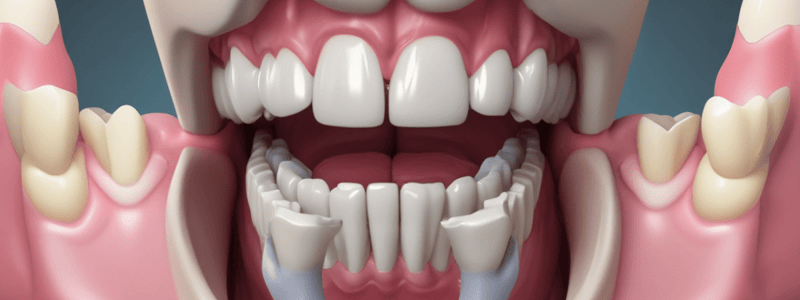Podcast
Questions and Answers
On the lingual surfaces of posterior teeth, the facial contour is located at which part of the crown?
On the lingual surfaces of posterior teeth, the facial contour is located at which part of the crown?
- Cervical third
- Middle third (correct)
- Occlusal third
- Incisal third
What is the primary consequence of over-contouring?
What is the primary consequence of over-contouring?
- Food impaction during mastication
- Insufficient stimulation of tissues by food
- Trauma to the attachment apparatus
- Chronic inflammatory state of the gingiva (correct)
Proximal contact areas are generally larger in which region?
Proximal contact areas are generally larger in which region?
- Molar region (correct)
- Canine region
- Incisor region
- Premolar region
What is the primary function of properly formed and located proximal contacts and associated embrasures?
What is the primary function of properly formed and located proximal contacts and associated embrasures?
What is the typical location of proximal contact areas in maxillary and mandibular central incisors?
What is the typical location of proximal contact areas in maxillary and mandibular central incisors?
What is the term for the V-shaped spaces that originate at the proximal contact between adjacent teeth?
What is the term for the V-shaped spaces that originate at the proximal contact between adjacent teeth?
Under-contouring can result in what kind of trauma?
Under-contouring can result in what kind of trauma?
What is the primary purpose of embrasures?
What is the primary purpose of embrasures?
Where are proximal contact areas typically located in posterior teeth?
Where are proximal contact areas typically located in posterior teeth?
What is the consequence of improper contours on oral health?
What is the consequence of improper contours on oral health?
What is the primary consequence of improper contacts between teeth?
What is the primary consequence of improper contacts between teeth?
What is the function of the correct relationships of embrasures, cusps to sulci, marginal ridges, and grooves?
What is the function of the correct relationships of embrasures, cusps to sulci, marginal ridges, and grooves?
What happens when an embrasure is decreased or absent?
What happens when an embrasure is decreased or absent?
What is the consequence of embrasures that are too large?
What is the consequence of embrasures that are too large?
What is one of the problems of improper restoration?
What is one of the problems of improper restoration?
What is the term used to describe the contact of teeth in opposing dental arches when the jaws are closed?
What is the term used to describe the contact of teeth in opposing dental arches when the jaws are closed?
What is the effect of the number and location of occlusal contacts between opposing teeth on muscle force?
What is the effect of the number and location of occlusal contacts between opposing teeth on muscle force?
What is the term used to describe the blunt, rounded, or pointed projections of the crowns of teeth?
What is the term used to describe the blunt, rounded, or pointed projections of the crowns of teeth?
What separates the facial cusps from the lingual cusps?
What separates the facial cusps from the lingual cusps?
What is the term used to describe the process of grinding and crushing food in the mouth?
What is the term used to describe the process of grinding and crushing food in the mouth?
What is the primary function of incisors during mastication?
What is the primary function of incisors during mastication?
Which of the following classes of teeth serve a dual role in mastication?
Which of the following classes of teeth serve a dual role in mastication?
What is the primary function of contours in relation to supporting tissues?
What is the primary function of contours in relation to supporting tissues?
What is the primary determinant of muscle function in mastication?
What is the primary determinant of muscle function in mastication?
What is the role of molars in relation to the vertical dimension of the face?
What is the role of molars in relation to the vertical dimension of the face?
What is the purpose of proximal contacts between teeth?
What is the purpose of proximal contacts between teeth?
What is the primary role of canines in occlusion?
What is the primary role of canines in occlusion?
What is the relationship between occlusal surfaces and periodontal disease?
What is the relationship between occlusal surfaces and periodontal disease?
What is the primary function of embrasures in relation to food?
What is the primary function of embrasures in relation to food?
What is the primary role of tooth preparation and restoration in relation to tooth function?
What is the primary role of tooth preparation and restoration in relation to tooth function?
What is the position of the mandible called when teeth are brought into full interdigitation with the maximal number of teeth contacting?
What is the position of the mandible called when teeth are brought into full interdigitation with the maximal number of teeth contacting?
What type of cusps contact opposing teeth along the central fossa occlusal line?
What type of cusps contact opposing teeth along the central fossa occlusal line?
What is the purpose of non-supporting cusps?
What is the purpose of non-supporting cusps?
What is the characteristic feature of supporting cusps according to the faciolingual center of the tooth?
What is the characteristic feature of supporting cusps according to the faciolingual center of the tooth?
What is the function of supporting cusps in mastication?
What is the function of supporting cusps in mastication?
What is the significance of the overlap of the cusps between posterior teeth?
What is the significance of the overlap of the cusps between posterior teeth?
What is the characteristic feature of non-supporting cusps compared to supporting cusps?
What is the characteristic feature of non-supporting cusps compared to supporting cusps?
What is the purpose of the depressions between the cusps?
What is the purpose of the depressions between the cusps?
What is the characteristic feature of the maxillary arch compared to the mandibular arch?
What is the characteristic feature of the maxillary arch compared to the mandibular arch?
What is the significance of the horizontal and vertical overlap of anterior teeth?
What is the significance of the horizontal and vertical overlap of anterior teeth?
Flashcards are hidden until you start studying
Study Notes
Posterior Teeth Contours and Contacts
- The facial contour on the lingual surfaces of posterior teeth is typically located at the cervical third of the crown.
- Over-contouring can lead to improper contacts, which may cause food impaction and periodontal issues.
- Proximal contact areas are generally larger in the posterior region compared to anterior teeth.
Functions and Locations of Proximal Contacts
- Properly formed proximal contacts and associated embrasures help maintain teeth alignment, protect periodontal tissues, and aid in effective mastication.
- In maxillary central incisors, proximal contact areas are typically located at the incisal third, while in mandibular central incisors, they are usually positioned at the incisal and middle third.
Embrasures and Their Implications
- The V-shaped spaces between adjacent teeth at the proximal contact areas are known as embrasures.
- Under-contouring can result in trauma from teeth rubbing against one another, leading to abrasion or sensitivity.
- The primary purpose of embrasures is to allow for the passage of food and facilitate the self-cleaning of teeth.
Proximal Contacts in Posterior Teeth
- In posterior teeth, proximal contact areas are typically located at the junction of the occlusal and middle thirds of the crown.
- Improper contours can contribute to oral health problems, such as increased plaque accumulation and potential dental caries.
Consequences of Improper Contacts
- Incorrect contacts between teeth can lead to uneven occlusal force distribution, potential tooth mobility, and discomfort.
- The relationships between embrasures, cusps to sulci, and marginal ridges help in smooth functional movements during chewing.
Embrasure Conditions
- A decreased or absent embrasure can hinder proper food flow and cleaning, leading to an increased risk of tooth decay.
- Embrasures that are too large may lead to food packing and difficulty in cleaning interproximal areas.
Restorations and Occlusion
- Improper restoration can cause various issues, including altered function and aesthetics, as well as compromised periodontal health.
- The term for teeth contact in opposing dental arches during closure is referred to as "maximum intercuspation."
Occlusal Contacts and Muscle Force
- The number and location of occlusal contacts significantly influence muscle forces, promoting effective mastication and oral comfort.
- The protruding crowns of teeth can be called cusps, which may be blunt, rounded, or pointed.
Masticatory Functions
- The grinding and crushing of food in the mouth is termed mastication, facilitated primarily by molars and premolars.
- Incisors primarily function to cut food, leading to effective initiation of mastication.
Role of Different Teeth Classes
- Molars and premolars serve a dual role in mastication by both grinding food and stabilizing occlusion.
- The anatomy of contours in teeth plays a crucial role in supporting oral tissues and facilitating proper function.
Muscle Function Factors
- The primary determinant of muscle function in mastication is the relationship between the upper and lower jaws during occlusion.
- Molars play a vital role in maintaining the vertical dimension of the face, which is essential for overall facial aesthetics and function.
Proximal Contacts Between Teeth
- Proximal contacts between teeth prevent food impaction and assist in stabilizing dental alignment.
- Canines play a key role in occlusion by guiding mandibular movements during function.
Occlusion and Periodontal Health
- There is a notable relationship between occlusal surfaces and the risk of periodontal disease, with improper contacts potentially exacerbating the condition.
Embrasures and Food Function
- Embrasures' primary function in relation to food is to direct it towards the occlusal surfaces, ensuring efficient mastication.
Restoration in Tooth Function
- Tooth preparation and restoration are critical for maintaining the functional integrity of teeth, ensuring they can withstand occlusal forces effectively.
Mandibular Position
- The position of the mandible during full occlusal contact is known as intercuspation, which is crucial for effective chewing mechanics.
Supporting and Non-Supporting Cusp Functions
- Supporting cusps are involved in occlusion with fossa contacts, primarily aiding in the grinding process during mastication.
- Non-supporting cusps serve to guide mandibular movements and assist in stabilizing the dental arch’s structure.
Curve Characteristics
- The overlap of cusps between posterior teeth aids in achieving a functional occlusion, ensuring effective food breakdown and distribution of forces.
- Maxillary arches typically display a wider and more rounded contour compared to the narrower mandibular arches.
Anterior Teeth Overlap Significance
- The horizontal and vertical overlap of anterior teeth is significant for optimal anterior guidance and aesthetic success during occlusion.
Studying That Suits You
Use AI to generate personalized quizzes and flashcards to suit your learning preferences.





